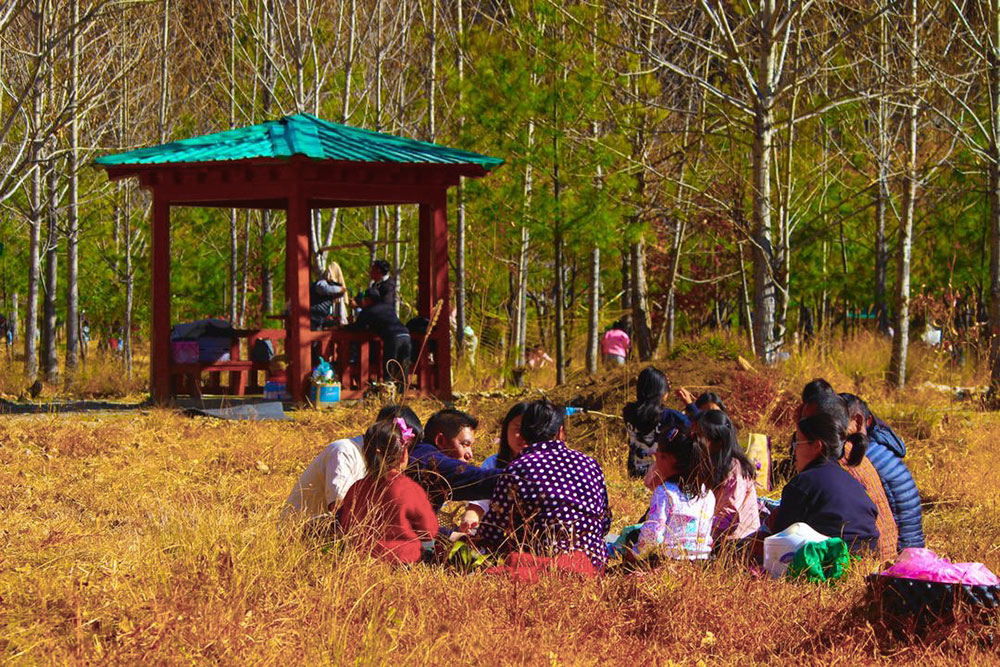Yangyel Lhaden
The Isuna Recreational Park, situated along the Thimphu-Paro highway, is becoming increasingly popular among locals, with approximately 33,000 visitors flocking to the park last year.
The park, spanning about six acres, is managed by the Green Bhutan Corporation Limited (GBCL) and has been open to the public since September 2022.
The park, formerly a landfill for construction materials like rock and sand during the widening of the Thimphu-Paro highway, has undergone a remarkable transformation.
The swing
Suspended above the river, this exhilarating feature offers visitors a thrilling experience as they soar through the air. Alongside the swing, the park offers various amenities, including a volleyball court, gazebos, picnic areas, restroom facilities, a children’s playground, and even a mini-pool designed specifically for young ones to enjoy.
“Daily, we welcome about 100 visitors, with the park reaching full capacity on weekends,” said Park Manager Pema Wangmo. “Families enjoy spending quality time here, and the park has also become a sought-after location for shooting music videos.”
The park operates from 9:00 am to 5:00 pm daily, but campers have the option to book the area for overnight stays. Entry fees are Nu 50 for Bhutanese nationals, Nu 30 for children aged six to 12, and Nu 150 for tourists.
The Isuna Recreational Park holds a special significance for GBCL beyond its role as a park.
“At the park, we promote green technology and use environmentally friendly sourced products which plays crucial role in climate-mitigation,” said GBCL’s chief executive officer, Karma Jigme Temphel. “By providing a space where both children and the elderly can connect with nature, we aim to foster a sense of conservation and appreciation for its beauty.”
In the park, the green trees undergo a stunning transformation, with their leaves turning orange during autumn and shedding them entirely in winter. This harmonious interplay with the seasons allows people to deeply connect with nature and appreciate its ever-changing beauty.
“The park aims to foster economic growth by promoting tourism and local businesses, while prioritising social engagement and environmental conservation. Through eco-tourism initiatives, we aim to create sustainable businesses that benefit both the community and the environment,” said Lenmith Lepcha, GBCL’s head of the Nursery Plantation and Floriculture Section.
With urbanisation limiting people’s access to natural environments and confining them to their homes, the recreational park plays a crucial role in providing a space for relaxation.
Tshering Dorji, general manager of GBCL, said: “There is a strong correlation between people’s connection with nature and the reduction of depression and anxiety.”
Pema Wangmo said that the land was covered in gravel and sand. ” We embarked on a meticulous journey of trial and error to nurture a diverse array of plant species within the park.
She said that the primary challenge was acquiring quality topsoil to fill the land. GBCL is currently experimenting with growing lawn grass in a small area. “It has been a success so far; it required two truckloads of topsoil for the pants to root.”
Navigating through the park, visitors may notice the uneven terrain resulting from the remnants of gravel and sand. “To enhance the park’s aesthetics and comfort, we plan to strategically layer topsoil in certain areas for the cultivation of flora and the growth of lush lawn grass, providing inviting spots for people to relax and enjoy.”
GBCL is steadily advancing the park’s development. Upcoming features include a small pond for fishes, a thrilling zip line, and an in-progress cafeteria to cater to visitors’ needs.


